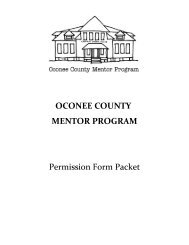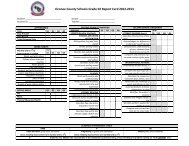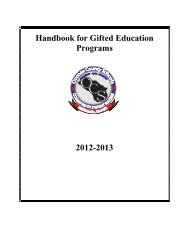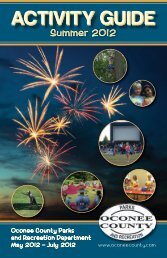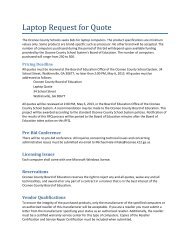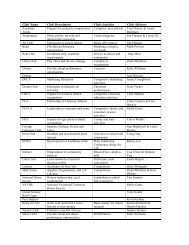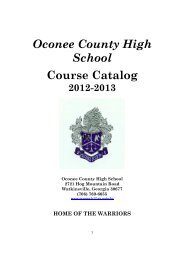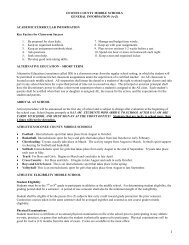North Oconee High - Oconee County Schools
North Oconee High - Oconee County Schools
North Oconee High - Oconee County Schools
You also want an ePaper? Increase the reach of your titles
YUMPU automatically turns print PDFs into web optimized ePapers that Google loves.
Accreditation Report<br />
<strong>North</strong> <strong>Oconee</strong> <strong>High</strong> School<br />
For the other four indicators, 5.1 - 5.4, we scored ourselves with twos, primarily because NOHS has not yet established and maintained a<br />
clearly defined, comprehensive student assessment system. This has been suggested as an addition to our School Improvement Plan,<br />
considering that so much of the SIP is based on test scores. (E) NOHS teachers design and use common assessments within departments<br />
and produce data from these assessments that measure student learning and school performance within the same course and throughout<br />
departments (F). Collaborating teachers meet regularly to plan common assessments and adjust pacing guides based on data. (G) The data<br />
produced influences how courses are paced and which topics are emphasized from semester to semester. The administration generally calls<br />
for consistent measurement across classrooms and courses through an expectation of collaboration. Assessments are carefully created,<br />
taking all students in mind, but they are seldom analyzed to determine if they are reliable and bias free. One way we are addressing this is<br />
that professional development in research-based test design has been provided to the English department as a part of the CCGPS roll-out.<br />
(H)<br />
Some procedures for collecting, analyzing, and applying learning from data sources are used by professional and support staff, such as<br />
using the instructional reports from AP exam results. (I, J) These data sources include some comparison and trend data about student<br />
learning, instruction, and the effectiveness of programs. (K) Teachers should receive staff development in assessment design in order to<br />
produce meaningful data. Teachers would benefit from professional development for both content-specific analysis of test results as well as<br />
analysis of the body of data available for each student. Time should also be provided for school personnel to meet in and across<br />
departments to use this data to make plans for instruction. School personnel use data to design and implement continuous improvement<br />
plans, but this is not consistent throughout the school. The use of data to drive instruction is highlighted by the administration which should<br />
promote this use. (L) Data analysis is an important part of the decision-making process at NOHS, but qualitative and anecdotal information is<br />
used as well (M-see Guiding Principles #11).<br />
Most professional and support staff members are assessed and trained in a professional development program related to the evaluation,<br />
interpretation, and use of data. This training is mostly limited to proctoring for state-mandated or other standardized tests. (N) Teachers<br />
incorporate student data as a part of measuring professional growth and student achievement. (O) Few of the academic teachers have<br />
received training in evaluation and interpreting and using data, and for these teachers the training has been from their own pursuits. (P)<br />
Small-group, content-specific professional learning on the interpretation and use of data would improve our performance on this standard.<br />
A process exists for analyzing data that determine improvement in student learning. (Q) In terms of readiness for and success at the next<br />
level, passing grades are the primary tool for recommendation for promotion to the next level in a discipline. (R) School-wide measures<br />
should be put into place to help the school decision makers determine improvement in student learning. Assessments are given to help<br />
students determine college and career readiness within CTAE fields. (S) Informal data analysis results indicate mixed levels of improvement,<br />
(T) and school personnel sometimes use these results to design, implement, and evaluate the results of continuous improvement action<br />
plans related to student learning, including readiness for and success at the next level. Some teachers discuss within departments the<br />
success of students in previous years and predict future success (U), but NOHS should develop a comprehensive system to evaluate student<br />
improvement and readiness for success at the next level.<br />
SY 2012-2013 Page 33<br />
© 2013 AdvancED www.advanc-ed.org



